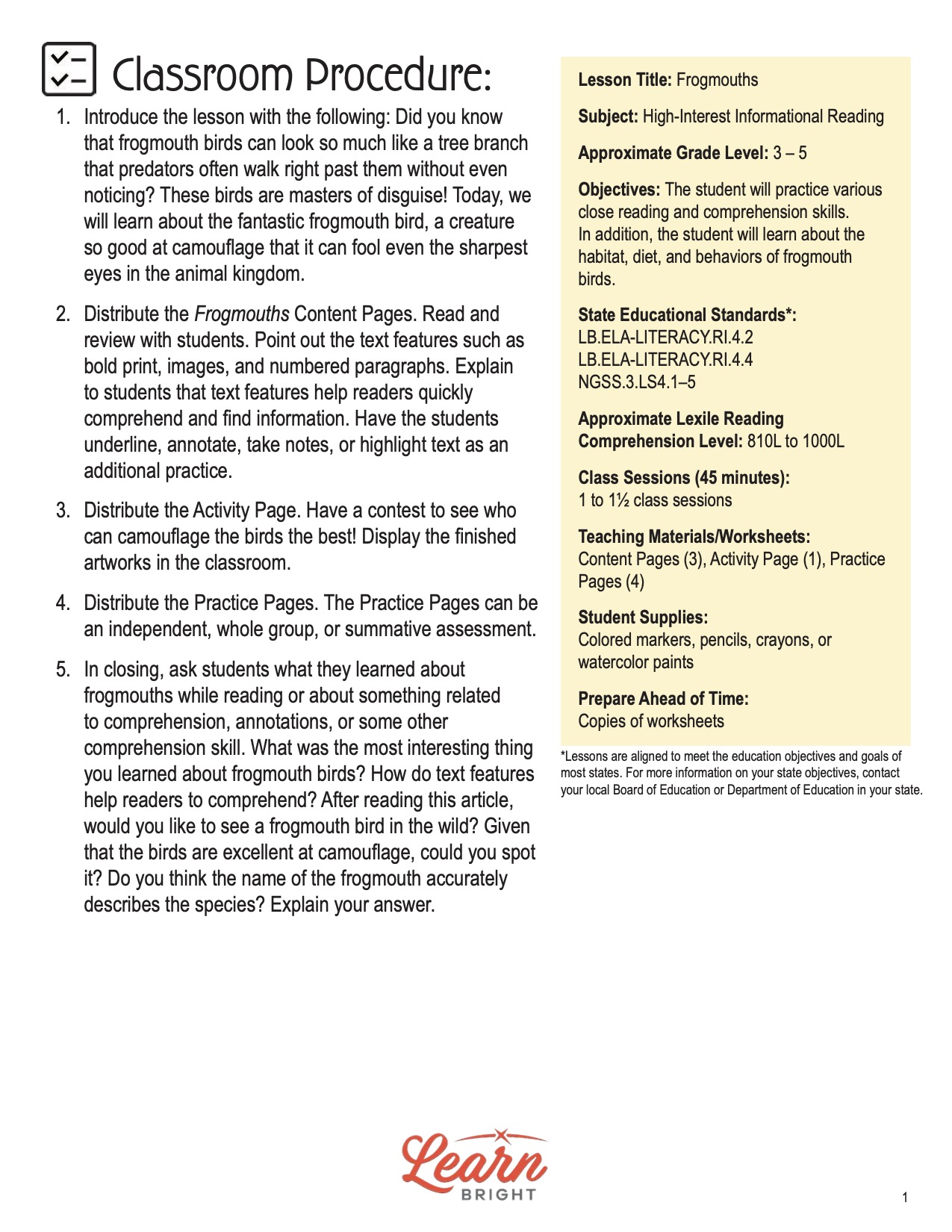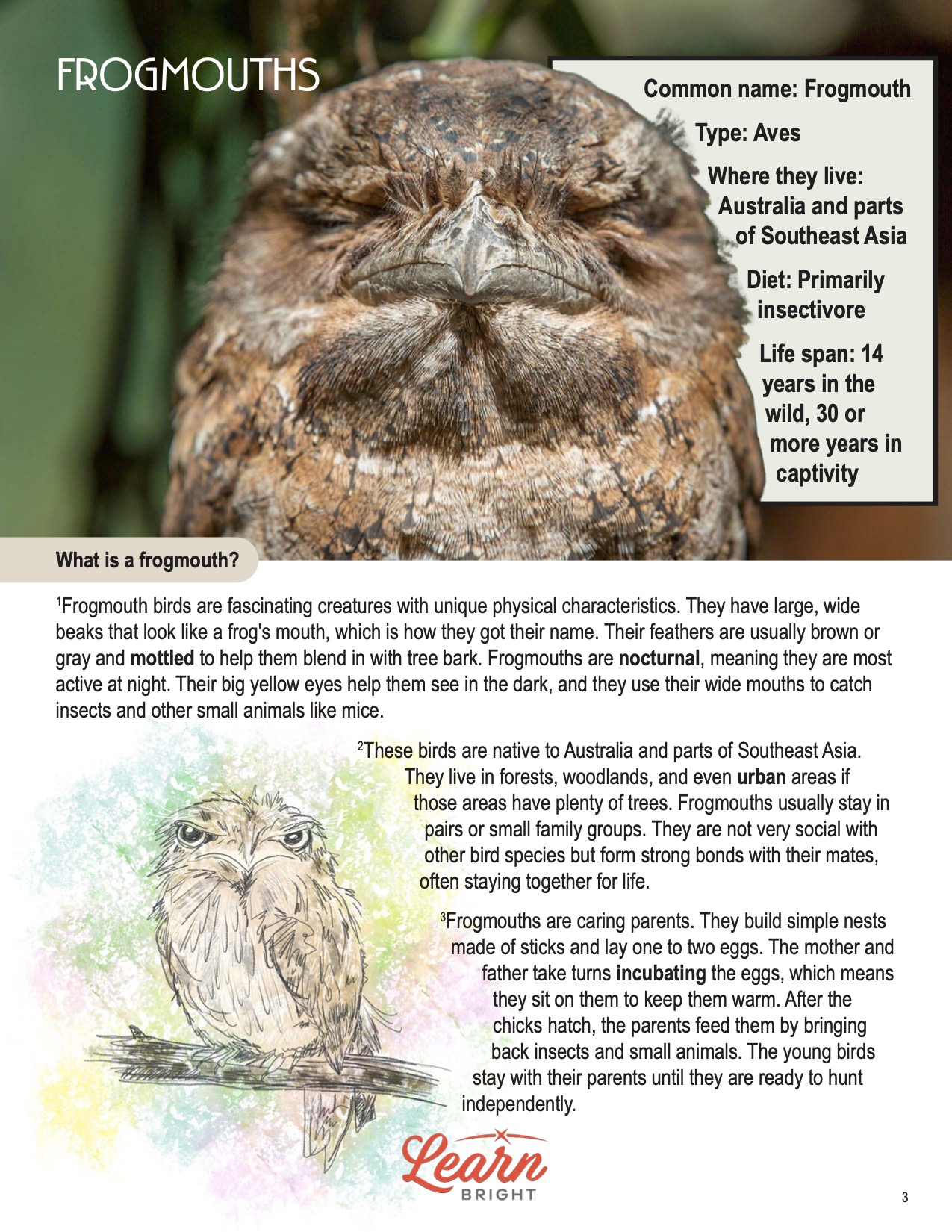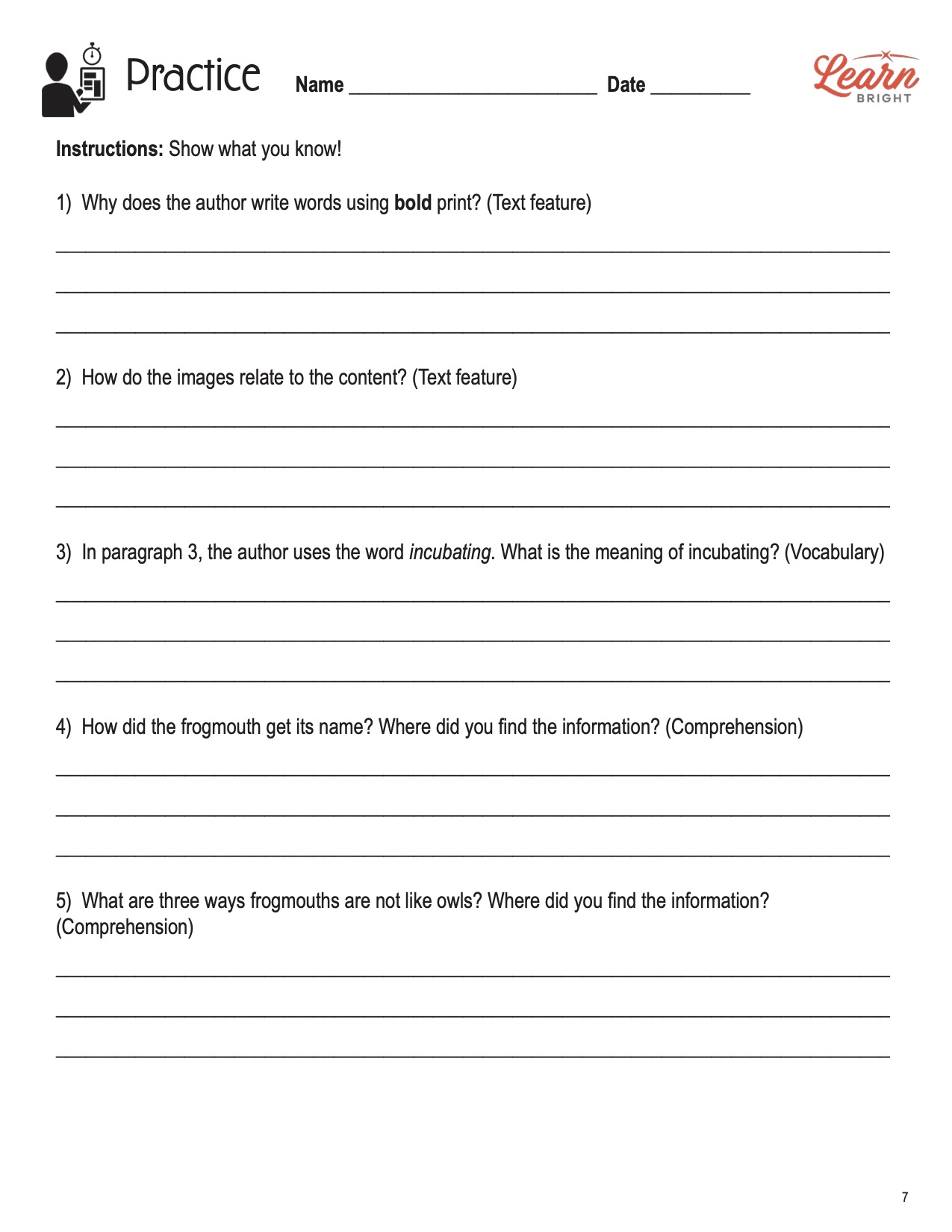Description
What our Frogmouths lesson plan includes
Lesson Objectives and Overview: Frogmouths is a high-interest reading comprehension lesson plan. As such, students will practice various close reading and comprehension skills. In addition, they will learn about the habitat, diet, and behaviors of this very unique bird. This lesson is for students in 3rd grade, 4th grade, and 5th grade.
Classroom Procedure
Every lesson plan provides you with a classroom procedure page that outlines a step-by-step guide to follow. You do not have to follow the guide exactly. The guide helps you organize the lesson and details when to hand out worksheets. It also lists information in the yellow box that you might find useful. You will find the lesson objectives, state standards, and number of class sessions the lesson should take to complete in this area. In addition, it describes the supplies you will need as well as what and how you need to prepare beforehand. The activity for this lesson requires colored markers, pencils, crayons, or watercolor paints.
Teacher Notes
The paragraph on this page provides a little more information or guidance on what to expect from the lesson. It explains that you can teach this lesson in a whole-class setting or as an independent, small-group activity. You can use the blank lines to record any thoughts or ideas you have as you prepare.
FROGMOUTHS LESSON PLAN CONTENT PAGES
What Are Frogmouths?
The Frogmouths lesson plan contains three content pages. It begins with a box of basic information about the owl-like bird. Frogmouths live in Australia and parts of Southeast Asia. The are primarily insectivores, feasting on bugs and insects. They live for about 14 years in the wild, but they can survive up to 30 or more years in captivity.
Frogmouth birds are fascinating creatures with unique physical characteristics. They have large, wide beaks that look like a frog’s mouth, which is how they got their name. Their feathers are usually brown or gray and mottled to help them blend in with tree bark. Frogmouths are nocturnal, meaning they are most active at night. Their big yellow eyes help them see in the dark, and they use their wide mouths to catch insects and other small animals like mice.
These birds are native to Australia and parts of Southeast Asia. They live in forests, woodlands, and even urban areas if those areas have plenty of trees. Frogmouths usually stay in pairs or small family groups. They are not very social with other bird species but form strong bonds with their mates, often staying together for life.
Frogmouths are caring parents. They build simple nests made of sticks and lay one to two eggs. The mother and father take turns incubating the eggs, which means they sit on them to keep them warm. After the chicks hatch, the parents feed them by bringing back insects and small animals. The young birds stay with their parents until they are ready to hunt independently.
Diet of a Frogmouth Bird
Frogmouth birds have a varied diet, including insects, spiders, and other small animals. They enjoy eating beetles, moths, grasshoppers, and even tiny frogs or mice. Since they are nocturnal, they hunt at night when many of their prey are active. They rely on their excellent night vision and sharp hearing to find food in the dark. Their large, wide beaks are perfect for catching their prey quickly.
When hunting, frogmouths use a technique called “sit-and-wait.” They perch very still on a branch, blending into the surroundings until an insect or small animal comes close. Once they spot their prey, they swoop silently and catch it with their powerful beaks. Frogmouths are not fast fliers, so they prefer to grab food from the ground or low branches rather than chase it through the air.
Interesting Facts
One of the coolest facts about frogmouths is that they are masters of camouflage. Their feather patterns blend so well with tree bark that they are almost invisible when sitting still. During the day, they perch on branches and remain motionless, using their camouflage to hide from predators like owls and hawks. If a predator gets too close, a frogmouth will freeze in place, stretching its body to look like a branch, to fool its enemies.
Another fascinating fact is that frogmouths are not owls. They look a lot alike, but they are part of different families. Unlike owls, frogmouths don’t have sharp talons for grabbing prey. Instead, they rely on their strong beaks to snatch insects and small animals. Also, unlike owls that fly around to hunt, frogmouth birds stay in one spot, waiting patiently for their prey to come to them. This makes them very different from many other nocturnal hunters.
Frogmouths are also known for their quiet nature. They don’t hoot like owls but make soft, low-pitched noises, including grunts and whistles. You might hear a frogmouth softly calling to its family at night, but these birds are generally quiet and blend into the darkness. This behavior helps them avoid attracting attention from predators and keeps them safe during their nighttime activities.
Why Frogmouths Are Important
Because they help control insect populations, frogmouths are very important to their environment. Eating beetles, moths, grasshoppers, and other insects keeps the number of bugs in check. This helps prevent insect infestations that could damage plants and crops. Frogmouths also play their role in the food chain by serving as prey for larger animals like owls and hawks.
Frogmouths are not considered endangered, but some species, like the Papuan frogmouth, face habitat loss. As forests are cut down for farming or building, these birds lose their homes and places to hunt. While many frogmouth species are still doing well in the wild, it’s critical to protect their habitats to make sure they can survive in the future. Conservation efforts that protect forests and woodlands can help keep frogmouths and other wildlife
safe.
FROGMOUTHS LESSON PLAN WORKSHEETS
The Frogmouths lesson plan includes two worksheets: an activity worksheet and a practice worksheet. Each one will help students solidify their grasp of the material they learned throughout the lesson. You can refer to the classroom procedure guidelines to know when to hand out each worksheet.
CAMOUFLAGE ACTIVITY WORKSHEET
For this activity, students will first color the picture of the frogmouth birds. Then they will draw and color around the birds to try and camouflage them into the background. Hang up students’ finished pictures around the classroom.
FROGMOUTHS REVIEW PRACTICE WORKSHEET
The practice worksheet requires students to answer a series of 10 questions. These questions all relate to the content pages, so students will need to refer to them often for the answers. In addition, each question provides which reading tool the question corresponds to, such as text feature, vocabulary, or comprehension.
Worksheet Answer Keys
At the end of the lesson plan document is an answer key for the practice worksheet. The correct answers are all in red to make it easier for you to compare them with students’ responses. If you choose to administer the lesson pages to your students via PDF, you will need to save a new file that omits these pages. Otherwise, you can simply print out the applicable pages and keep these as reference for yourself when grading assignments.









